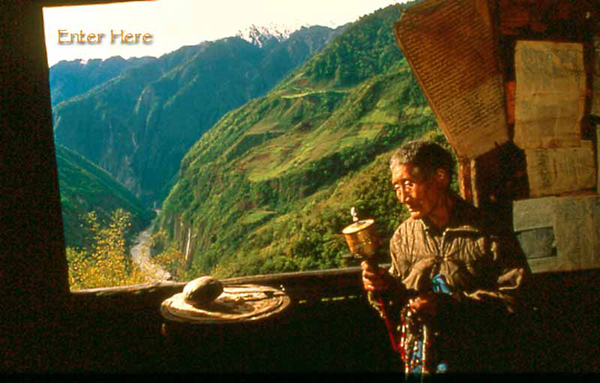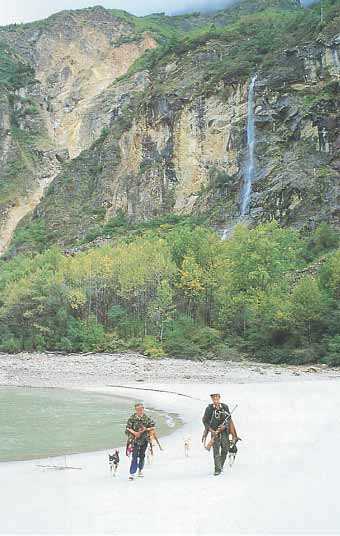| Arizona Canyoneers | Richard D. Fisher |
|
|
click here for our NEW! Tibet Newsletter - NEW YORK TIMES, April 12, 2005 Canyonlands of Tibet and Central Asia When Richard D. Fisher emerged from the Yarlung Tsangpo Gorge in October 1992, he found that this most mysterious chasm on earth had just been identified by Outside Magazine October, 1992, as "one of the last great unexplored areas on earth." While in the canyon, Fisher had an epiphany that this was one of the last great sacred spaces on the planet to be explored by westerners. He was so enthusiastic about the beauty and drama of this huge cloud shrouded gorge that at that moment he did not consider what effects there might be from the neo-colonialist attitudes of explorers who would follow him. As a spiritualist from the best ideals of the 1960s, it did not occur to him that his pioneering efforts would lead to an old fashioned race to see who would get the credit for this phenomenal discovery. The first thing he did was invite Outside Magazine, National Geographic, and others to join him in what has turned out to be a decade of intensive and contentious exploration.
In 1996 the Guinness Book of Records recognized Richard D. Fisher as the first to identify the canyon as the earth's deepest.
"For many years, the Yarlung Tsangpo in eastern Tibet was known to be among the deepest valleys in the world. Its inaccessibility meant that its depth could not be directly measured-until 1993, when, after 10 years of trying, explorer Richard Fisher obtained the permits he needed to visit the area. British botanist Francis Kingdon Ward explored (the west end of) the Yarlung Tsangpo at the beginning of the century, but no other Westerners were able to do so until Fisher led his expedition there.
With a group of fellow Americans, plus Chinese and Tibetan colleagues and Minba and Loba tribal co-explorers, Fisher set off into the unknown. The result was clear-cut: the discovery of the deepest valley on earth.
With soaring peaks on either side of the Yarlung Tsangpo, measurements were extremely difficult to take, but the conclusion was that the valley is 16,650 feet deep near the Tibet-India border. The peaks of Namche Barwa (25,436 feet) and Jala Peri (23,891 feet) are 13 miles apart, and the Yarlung Tsangpo River flows between them at an elevation of 8,000 feet.
Richard Fisher says the Yarlung Tsangpo is the only chasm he has encountered that compares with the Grand Canyon for sheer beauty. Fisher adds, "The Yarlung Tsangpo is so vast and diverse that it must contain many mysteries yet to be discovered."
Asiaweek said on January 26, 1994, in the science section, "Scientists explore Tibet's deepest wonder... on an exploratory trip in October, 1992, he found an exciting variety of wildlife, virgin forest, tribal groups, and a canyon of massive proportions." Fisher returned in April with a team of the U.S., Chinese, and Tibetan scientists to identify this as the earth's deepest canyon. The canyon "fascinated Fisher for other reasons. Tibetan tribes have lived in the lush canyon for at least 2,000 years. Its inaccessibility made it an ideal refuge for people escaping the region's political and religious upheavals. 'They had never seen foreigners before, except for the British in the 1920s,' says Fisher. Equally interesting for the fifteen-member team, which included a botanist and a geologist from the University of Arizona, was the canyon's ecology. 'It holds the most diverse wildlife and forests in the Himalya,' reckons Fisher. 'Some groups are probably extinct everywhere else.' Among them: snow leopards, tigers, an antelope-like goat and various types of mountain sheep. The team also discovered huge trees that Fisher believes may be the largest in Asia."
In September, 1994, Men's Journal reports "Fisher, four whitewater veterans and six trekkers-arrived at the village of Gyala, a put-in point along the river above the Great Bend, in mid-April 1993." The article by Michael McRae details the first western style competition to be recognized as the "discoverer" of the earth's deepest canyon. This race was to go on for over a decade with many players sponsored by some of the most prestigious and wealthy institutions in the U.S.A. and China.
One of the last remaining controversies was the "discovery" of a remote waterfall on the river aptly named Hidden Falls. After being viewed by seven of the top American explorers, none could find an angle for a full face photograph or accurately measure this elusive falls which cascades into an impenetrable "slot canyon." This falls is estimated to be between 60 and 100 feet high, but no one can be certain. It is known, however, that it is not the 150 foot falls described by Kintup.
One of the expeditions, in 2002, has suggested that the Falls is actually misidentified. Earlier in the century a British secret agent from Nepal named Kintup reported a 150 foot waterfalls identifying the entrance of the gorge. In fact, there is such a waterfalls in the location that Kintup described, but it was not on the main river, rather it was from a tributary cascading into the river. While much has been made of Hidden Falls, perhaps this misinterpretation of the historical record has made the entire issue (of a major 150 foot falls on the river) a rather moot point. Kintup's report started one of the most ill-fated and most bitter controversies in the history of modern exploration. Perhaps these questions concerning the Hidden Falls can be laid to rest forever?
Kintup Falls marks the entry portal into the Yarlung Tsang Po Canyon and is the origins of the controversial and contested search for a150 ft. waterfalls in (to) the river. It is quite spectacular during the frequent flood events. Perhaps the kayaking expedition of 2002 will hopefully close this phase of neo-colonialist exploration. One of the nation's leading magazines trumpeted in June 2002 "Triumph in Tibet, Knocking Off the Tsangpo." This expedition did clearly identify one major valuable point. The best kayakers on earth can only run very short class 6 sections of the canyon under the very best conditions. This should lay to rest the competition of who saw and did what first, and the wonders of the canyon itself will become, very appropriately, the most important focus.
Of these expeditions, Fisher remarks, "I did not want this incredible canyon to become an Everest-style killing fields." This canyon cannot be "knocked off" or conquered. Everest is a holy mountain as the Tsangpo is an equally important sacred canyon. Everest represents the male earth and the Tsangpo, the female hidden lands of this planet. It is a great blessing for all those who love the earth that, god willing, we have passed into a new era for the Tsangpo. This living canyon has withstood an almost military western style assault. "Today this chasm remains as elusive, beautiful and fresh as the first day I saw it in 1992," Fisher said.
Before and since Fisher's last expedition to the canyon in May 2000, he has moved on to exploring the other great canyons of Central Asia including the Kara Kash Canyon in the extreme northwestern corner of the Tibetan Plateau where he found the "Lost Marco Polo Jade Mines." His primary interest has always been tribal groups such as the Uyghur culture of the Kara Kash Canyon and the "lost Tibetan tribes" along the exceedingly remote grand canyons of the Mekong and Salween Canyons of Central Asia. "Here are hidden some of the greatest human cultural treasures found on earth. After my Yarlung Tsangpo experience, I am much more careful to guard the secrets of these unknown and undisturbed ethnic enclaves in these hidden lands." These remain the last pure and free tribes on earth.
|
|
Canyonlands Website - (with full navigation links) without navigation |
|
copyright Richard D Fisher/DigitalTeamWorks.com 2004

